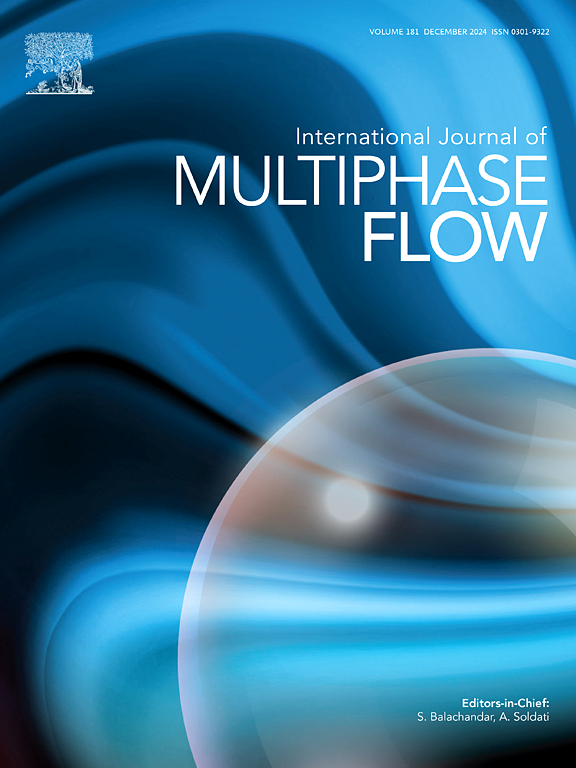异步平行高速垂直入水汽缸空腔演化研究
IF 3.6
2区 工程技术
Q1 MECHANICS
International Journal of Multiphase Flow
Pub Date : 2025-02-03
DOI:10.1016/j.ijmultiphaseflow.2025.105164
引用次数: 0
摘要
本研究对圆柱的异步平行高速垂直入水进行了广泛的实验研究,考察了不同横向间距、时间间隔和入水速度的影响。该研究确定了第一腔和第二腔的四种不同的腔形态模式。对于第一个空腔,这些模式包括不存在/破坏、压缩和准单腔,而第二个空腔则呈现不存在/破坏、压缩、扩展和准单腔形式。研究发现,影响空腔形态的参数多种多样,其中时间间隔是一个尤为重要的因素。研究表明,空腔形成过程具有复杂的动力学特征,第一空腔的最大直径随时间间隔的增加而增加,而其最大长度则呈现先减小后增大的非单调趋势。第二个空腔表现出更复杂的行为,其最大直径最初增加,然后随着时间间隔减小,随后出现微小波动。其最大长度呈现出明显的先减小后增大的非单调趋势,并有较大的波动。值得注意的是,第二空腔的最大直径的位置始终与第一空腔的塌陷面对齐。根据影响函数φ的定义,揭示了平行入水过程中空腔相互作用的复杂动力学。随着时间间隔的增加,第二空腔对第一空腔的影响逐渐减弱。相反,第一个空腔对第二个空腔的影响呈现出非单调的趋势:最初增强,随后减弱。当时间间隔等于圆柱长度与入水速度之比时,影响达到峰值。值得注意的是,当时间间隔超过临界阈值(定义为相同速度下单个空腔最大长度与水进入速度之比)时,第一和第二空腔之间的相互影响变得可以忽略不计。该分析阐明了平行高速入水过程中空腔形成和相互作用的复杂时间依赖性,为此类现象的流体动力学提供了有价值的见解。本文章由计算机程序翻译,如有差异,请以英文原文为准。

Study on cavity evolution of asynchronous parallel high-speed vertical water entry of cylinders
This study conducted extensive experimental investigations on the asynchronous parallel high-speed vertical water entry of cylinders, examining the effects of varying lateral spacing, time intervals, and entry speeds. The research identified four distinct modes of cavity morphology for both the first and second cavities. For the first cavity, these modes include non-existent/destroyed, compressed, and quasi-single cavity, while the second cavity exhibits non-existent/destroyed, compressed, expanded, and quasi-single cavity forms. Multiple parameters were found to affect cavity morphology, with time interval emerging as a particularly crucial factor. The study revealed complex dynamics in cavity formation: the maximum diameter of the first cavity increases with increasing time intervals, while its maximum length exhibits a non-monotonic trend, initially decreasing and then increasing. The second cavity demonstrates even more intricate behavior, with its maximum diameter initially increasing, then decreasing with time intervals, followed by minor fluctuations. Its maximum length shows a pronounced non-monotonic trend, first decreasing, then increasing, followed by significant fluctuations. Notably, the position of the maximum diameter of the second cavity consistently aligns with the collapse plane of the first cavity. This study reveals complex dynamics in cavity interactions during parallel water entry based on the influence function φ defined. As the time interval increases, the impact of the second cavity on the first cavity progressively attenuates. Conversely, the influence of the first cavity on the second exhibits a non-monotonic trend: initially intensifying, then subsequently diminishing. The peak influence occurs when the time interval equals the ratio of the cylinder length to the water entry speed. Notably, when the time interval exceeds a critical threshold, defined as the ratio of the maximum length of a single cavity at the same speed to the water entry speed, the mutual influence between the first and second cavities becomes negligible. This analysis elucidates the intricate temporal dependencies in cavity formation and interaction during parallel high-speed water entries, providing valuable insights into the fluid dynamics of such phenomena.
求助全文
通过发布文献求助,成功后即可免费获取论文全文。
去求助
来源期刊
CiteScore
7.30
自引率
10.50%
发文量
244
审稿时长
4 months
期刊介绍:
The International Journal of Multiphase Flow publishes analytical, numerical and experimental articles of lasting interest. The scope of the journal includes all aspects of mass, momentum and energy exchange phenomena among different phases such as occur in disperse flows, gas–liquid and liquid–liquid flows, flows in porous media, boiling, granular flows and others.
The journal publishes full papers, brief communications and conference announcements.

 求助内容:
求助内容: 应助结果提醒方式:
应助结果提醒方式:


